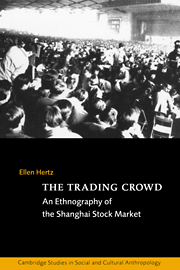Book contents
- Frontmatter
- Contents
- List of illustrations
- Preface
- Acknowledgments
- List of abbreviations
- Conversion rate
- Introduction: Ways and means
- Part I
- Part II
- 5 The big players (dahu)
- 6 The dispersed players (sanhu)
- 7 Guojia: The rise and fall of a super-player
- 8 Conclusion: The trading crowd
- 9 Afterwords
- Glossary of Chinese terms
- Bibliography
- Index
- More titles in the Cambridge Studies in Social and Cultural Anthropology series
8 - Conclusion: The trading crowd
Published online by Cambridge University Press: 05 June 2012
- Frontmatter
- Contents
- List of illustrations
- Preface
- Acknowledgments
- List of abbreviations
- Conversion rate
- Introduction: Ways and means
- Part I
- Part II
- 5 The big players (dahu)
- 6 The dispersed players (sanhu)
- 7 Guojia: The rise and fall of a super-player
- 8 Conclusion: The trading crowd
- 9 Afterwords
- Glossary of Chinese terms
- Bibliography
- Index
- More titles in the Cambridge Studies in Social and Cultural Anthropology series
Summary
The story of the Shanghai stock market in 1992 started with a boom and ended with a bust. Over the course of this speculative cycle, the three collective actors I have discussed – big players, dispersed players and the state – were each, at a certain point, attributed the power to move the stock market in their particular way. The dynamics of government regulation and market movement which were played out that year were obvious to all investors; they served as an allegory for the relative strengths of “the State” and “the People,” the latter in the dual form of a hyperbolized individual (the big player) and a chaotic collectivity (the dispersed players). In the process, something new – a new dynamic associated with a new kind of collective actor – emerged. I have called this something “the trading crowd.”
The speculative cycle of 1992 was kicked off by the big players: in the eyes of investors, the minuscule and highly regulated market of the beginning of the year was governed primarily by the cartelizing techniques of these masters. Next, as the market grew in size over the spring and summer, the state was seen as taking the upper hand. Though “the State” received no credit for the spectacular rise of the market from February to May 1992, the market's decline from May to September of that year was universally blamed, even by state officials themselves, on the decisions and pronouncements of state officials, in short on “state interference” (guojia ganshe).
- Type
- Chapter
- Information
- The Trading CrowdAn Ethnography of the Shanghai Stock Market, pp. 188 - 190Publisher: Cambridge University PressPrint publication year: 1998

